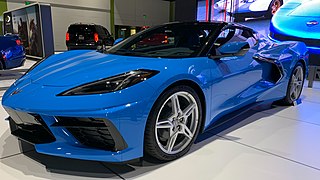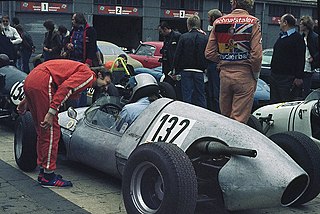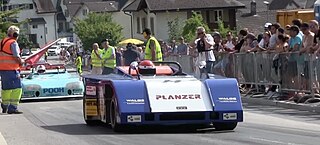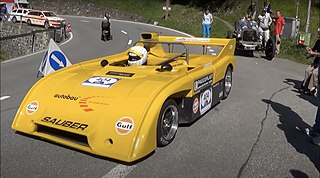
Cosworth is a British automotive engineering company founded in London in 1958, specialising in high-performance internal combustion engines, powertrain, and electronics for automobile racing (motorsport) and mainstream automotive industries. Cosworth is based in Northampton England, with facilities in Cottenham England, Silverstone England, and Indianapolis IN US.

The Chevrolet Corvette is a two-door, two-passenger luxury sports car manufactured and marketed by Chevrolet since 1953. With eight design generations, noted sequentially from C1 to C8, the Corvette is noted for its performance and distinctive fiberglass or composite panels. It was front-engined through 2019 and mid-engined since.

The AMC Javelin is an American front-engine, rear-wheel-drive, two-door hardtop automobile manufactured by American Motors Corporation (AMC) across two generations, 1968 through 1970 and 1971 through 1974 model years. The car was positioned and marketed in the pony car market segment.

Peter Paul Sauber is a retired Swiss motorsport executive. He was the team principal and owner of various motorsports teams, most visibly the eponymous Sauber Formula One team.

Formula Junior is an open wheel formula racing class first adopted in October 1958 by the CSI. The class was intended to provide an entry level class where drivers could use inexpensive mechanical components from ordinary automobiles. The idea to form the new class came from Count Giovanni "Johnny" Lurani who saw the need of a class for single-seater racing cars where younger drivers could take their first steps. It is often speculated that this class was founded as a reaction to Italy's lack of success in the 500cc Formula Three, and although Italian marques dominated the first year of the formula, they were soon overtaken by British constructors.

Throughout its history, BMW cars and motorcycles have been successful in a range of motorsport activities. Apart from the factory efforts, many privateer teams enter BMW road cars in touring car racing. BMW also entered cars or provided engines in Formula One, Formula Two and sportscar racing. BMW is currently active in IMSA, the Isle of Man TT, the North West 200, the Superbike World Championship and the Deutsche Tourenwagen Masters.
Sauber Motorsport AG is a Swiss motorsport engineering company. It was founded in 1970 by Peter Sauber, who progressed through hillclimbing and the World Sportscar Championship to reach Formula One in 1993. After operating it under their own name from 1993 until 2018, Sauber Motorsport AG renamed their Formula One racing team to Alfa Romeo Racing.
Max Welti is a former Swiss racing driver, Sauber's first team manager and thus double winner of the 24 Hours of Le Mans as well as two-time sports car world champion with Sauber Mercedes. Five years later, he wins the 24 Hours of Le Mans for a second time with Porsche as the responsible race director. He then returns to Sauber as overall manager of the Sauber Formula One operation. In 2000 Welti becomes CEO of the European silhouette touring car racing series "V8STAR" before becoming team owner of A1 A1 Team Switzerland in 2005. As an international motorsport strategist and consultant, Welti nowadays works for OEMs, promoters and organisers.

The Mercedes-Benz C11 is a Group C prototype race car introduced for the 1990 World Sports-Prototype Championship. Built by Sauber as a successor to the Sauber C9, the C11 used the same Mercedes-Benz M119 5.0L twin turbo V8. It was the first time that Mercedes-Benz chose to put their name on the car, instead of simply using Sauber.
Throughout its long history, Mercedes-Benz has been involved in a range of successful motorsport activities, including sportscar racing, touring car racing, Grand Prix racing, and rallying. It is currently active in GT racing, Formula E and Formula One.

The Sauber SHS C6 was a Group C prototype racing car built by Swiss manufacturer Sauber and engineering firm Seger & Hoffman, intended for competition in the World Endurance Championship and Deutsche Rennsport Meisterschaft series. Seger & Hoffman left the project later in 1982, leaving the car completely under Sauber's control.

During its history, Alfa Romeo has competed successfully in many different categories of motorsport, including Grand Prix motor racing, Formula One, sportscar racing, touring car racing and rallies. They have competed both as a constructor and an engine supplier, via works entries and private entries. The first racing car was made in 1913, three years after the foundation of A.L.F.A., the 40/60 HP had 6-litre straight-4 engine. Alfa Romeo quickly gained a good name in motorsport and gave a sporty image to the whole marque.
Italian motor manufacturer Alfa Romeo has participated many times in Formula One. It currently participates as Alfa Romeo F1 Team Stake while being operated by Sauber Motorsport AG. The brand has competed in motor racing as both a constructor and engine supplier sporadically between 1950 and 1987, and later as a commercial partner since 2015. The company's works drivers won the first two World Drivers' Championships in the pre-war Alfetta: Nino Farina in 1950 and Juan Manuel Fangio in 1951. Following these successes, Alfa Romeo withdrew from Formula One.

The Sauber C22 was the Formula One car that Sauber Petronas used to compete in the 2003 Formula One season.
The Alba AR2 was a Group C junior sports car prototype, designed, developed and built by Italian manufacturer Alba Engineering in 1983, and used in sports car racing until 1995.

The Sauber C5 is a Group 6 prototype racing car, designed, developed and built by the Swiss Sauber team, specifically made to compete in the 1977 24 Hours of Le Mans and the 1978 24 Hours of Le Mans. It is powered by a naturally aspirated 300 hp (220 kW) BMW M12 four-cylinder engine. It scored 15 race wins, 31 podiums, clinched 1 pole position, and 6 wins in its class. With these statistics, it makes it one of the most successful early Sauber sports cars.

The Sauber C2 was the second prototype racing car that Swiss Peter Sauber designed and developed. It was built in 1971. It scored three race wins and seven podium finishes. It was powered by a naturally aspirated 1.6 L (98 cu in) Ford-Cosworth BDA four-cylinder engine, with 240 hp (180 kW). It was also very light, weighing only 480 kg (1,060 lb).

The Sauber C3 was the third sports prototype racing car that Swiss Peter Sauber designed and developed. It was built in 1973. It scored one race win, seven podium finishes, clinched one pole position, and achieved three additional wins in its class. It was powered by a naturally aspirated 2.0 L (120 cu in) Ford-Cosworth BDG four-cylinder engine, developing 280 hp (210 kW).
The Sauber C4 was the fourth sports prototype racing car that Swiss Peter Sauber designed and developed. It was built in 1975. It competed in the European 2-Litre Sportscar Championship, where it managed to score 1 win and 5 podium finishes. It was powered by the same naturally aspirated 2.0 L (120 cu in) Ford-Cosworth BDG four-cylinder engine as its predecessor, developing 275 hp (205 kW).













